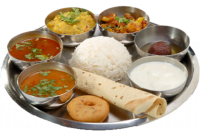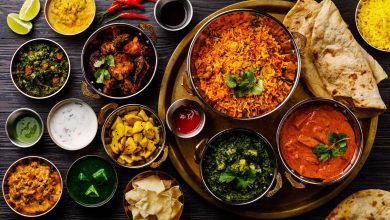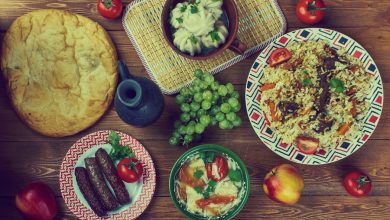How is food eaten in India:
In India, food is usually eaten with the right finger, especially in rural and traditional areas. This custom has deep roots in Indian culture and is considered part of dining etiquette. However, in urban and modern environments, utensils such as spoons, forks and knives are also commonly used, especially for foods such as rice, curry and other dishes.
Here is a general overview of how food is consumed in India:
Using fingers:
Eating with your fingers is a common practice in India, especially for foods such as roti (Indian bread), rice and various curries. The right hand is often used for this purpose, while the left hand is considered unclean and is not usually used for eating or drinking.
Roti or bread:
Roti, naan, paratha or other Indian breads are torn into pieces as small as the fingers of the right hand. These pieces are then used to collect and pick different types of curries or vegetables.
Rice:
When eating rice, people often use their fingers to mix the rice into various curries or lentil soups. Fingers are used to roll rice into small portions and then eat.
Curry and vegetables:
Curries and vegetables are often served in communal dishes and everyone uses their fingers or utensils to scoop the curry onto their plates. The curry is then mixed with rice or bread and eaten.
Soups and Dals:
Soups and dals are usually eaten by spooning or using bread to soak up the liquid.
Pickles and spices:
Indian dishes often include a variety of pickles, chutneys and spices eaten in small quantities to add flavor to the meal. They are often taken with a small spoon or applied directly to bread or rice.
Desserts:
Desserts are often eaten with a spoon or fork, especially products such as puddings, cakes or ice cream. It’s important to note that practices may vary by region, cultural preferences, and personal habits. Additionally, in more formal or professional settings, the use of utensils is common and considered appropriate. In general, choosing eating utensils or eating with your fingers depends largely on personal preferences and the type of food eaten.
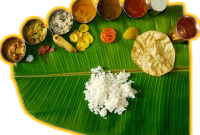

What is traditional Indian food:
Traditional Indian cuisine is extremely diverse, reflecting the diverse cultures, climates, religions and regions of the Indian subcontinent. Indian cuisine is famous for its use of aromatic spices, vibrant flavors and diversity of ingredients. The traditional Indian diet typically includes a variety of grains, legumes, vegetables, fruits, dairy products, and spices. Here are some key elements and dishes considered traditional in Indian cuisine:
Rice and wheat: Rice and wheat are the staple grains in many parts of India. Rice is the staple food in the southern and eastern regions, while wheat is more common in the northern regions. Different types of rice, such as Basmati rice, are widely used.
Dals and lentils: Lentils and beans, collectively known as “dals”, are important sources of protein and an essential part of Indian cuisine. Dals are often prepared with spices and served with rice or bread.
Curry: Indian curry is a basic part of the cuisine, consisting of a mixture of vegetables, meat or pulses cooked in various spicy sauces. The curry is seasoned with a combination of spices like cumin, coriander, turmeric and garam masala.
Vegetarian dishes: India has a rich vegetarian tradition and the majority of the population follows a vegetarian diet. Vegetarian dishes are varied and can range from simple stir-fried vegetables to complex and spicy dishes such as Chana Masala (spicy green beans) and Aloo Gobi (potato and cauliflower curry).
Non-vegetarian dishes: In areas where non-vegetarian food is popular, dishes like chicken curry, Rogan Josh (mutton curry), tandoori chicken, butter chicken and fish curry are popular. These dishes are often spicy and have many different flavors.
Bread: Different types of bread are a staple in Indian cuisine. Examples include Roti, Naan, Paratha, Puri and Chapati, which are often made from wheat flour and accompany curries and other dishes.
Snacks and street food: India is famous for its diverse and delicious street food, including dishes like Samosas, Pakoras, Bhel Puri, Chaat and Vada Pav. These snacks are enjoyed throughout the day and often highlight regional flavors.
Milk product: Dairy products like yogurt (curd), ghee (clarified butter), Indian cheese and various dairy dishes are widely consumed in Indian cuisine.
Sweets and desserts: Indian desserts are very diverse and are often sweetened with ingredients such as sugar, jaggery or condensed milk. Popular desserts include Gulab Jamun, Jalebi, Kheer, Barfi and Halwa.
Spices and seasonings: Spices play an important role in Indian cuisine as they add flavor and aroma. Popular spices include cumin, coriander, turmeric, cardamom, cinnamon and cloves. Garam masala, a spice mixture, is also widely used.
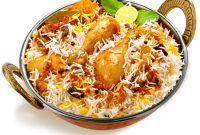
Traditional Indian cuisine is characterized by the use of aromatic spices, bright colors and a harmonious balance of sweet, salty, sour and spicy tastes. Regional variations and diverse culinary traditions contribute to the richness and diversity of Indian cuisine.
